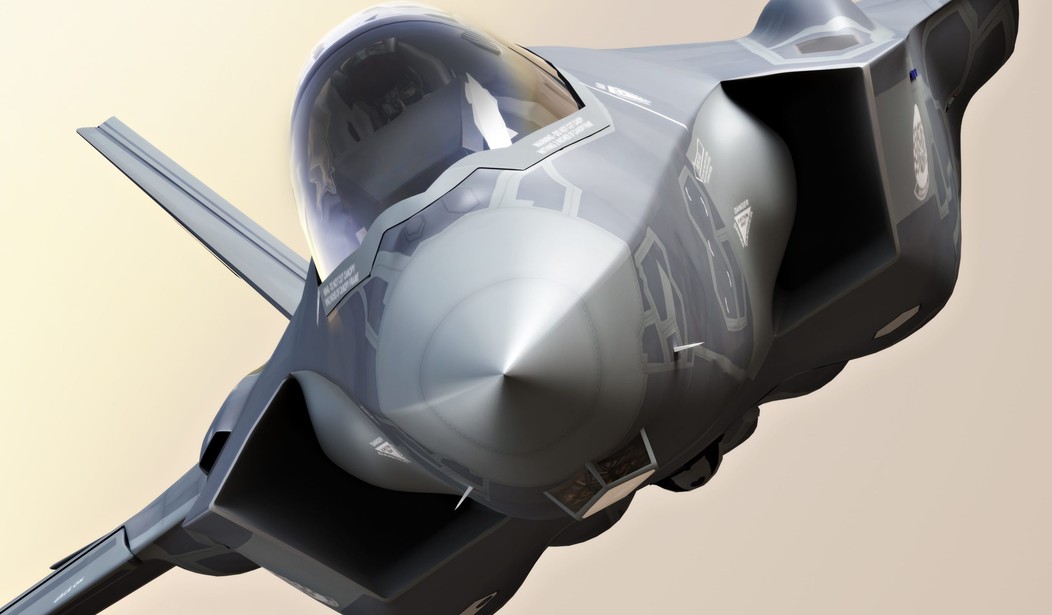It’s been a long time coming, but the very first F-35I Adir rolled off the Lockheed-Martin assembly line in Fort Worth yesterday for a scheduled December delivery to the Israeli Air Force:
Israel’s air force, which will be the first to have a fully operational F-35 outside the United States, is scheduled to buy 33 Lightning IIs and has an option to buy 17 more. The aircraft on stage Wednesday will undergo additional testing before being delivered in December.
Analysts say that Israel’s purchase of the fighter already means that the Jewish state will be the dominant air power in the Middle East for the foreseeable future. The F-35 is so crucial to the country’s defense that Wednesday’s rollout ceremony was broadcast live on Israeli television.
The event in the Fort Worth hangar sparked tweets from around the world. The Israelis, more than once, praised the Obama administration for supporting their defense with the purchase of the F-35, with Liberman saying it came despite the countries’ disputes over how it deals with its neighbors.
Whatever you might think of the F-35 — it’s late and overpriced, and just one reason why I have a recurring Procurement Blues feature — the Israelis promise to make it better. Or do they threaten to?
Read:
Perhaps betraying their reservations about what usually happens the American weapons after the Israelis lay their hands on them, Lockheed executives said Israel would be able to add specific capabilities or upgraded functions—which the Israelis love doing—as long as it did not affect the overall design or the aircraft software. As Over put it:
The Israelis have an ability to do some unique things. But anything wholesale that would impact the design or capabilities driving all the airplanes for all the countries would have to be done by consensual agreement.
The IAF is preparing to send its first group of pilots to train in Arizona next year, at the Luke Air Force Base. At the same time, the IAF will be sending dozens of maintenance professionals to train at US Air Force logistics bases at Eglin, Florida, according to Defense News.
Good luck stopping the IAF from modifying the platform to suit Israel’s needs rather than Lockheed’s — and the IAF has quite a history of doing just that, as you’ll see below.
The latest Israeli mods to the F-16I Sufa (based on the US F-16D Block 52) include “Conformal Fuel Tanks, dorsal spine, and numerous fairings and bulges for undisclosed equipment. Rumor has it that a lot of the equipment is only installed after delivery to Israel,” for a jet which even looks “radically different” from a vanilla model. [Emphasis added]
And it isn’t just the F-16 Israel has toyed with. They’ve also made major mods to their version of the F-15E Strike Eagle, the F-15I Ra’am:
Several modifications had been carried out in the Ra’am, in order to meet Heyl Ha’avir’s unique needs and specifications. For instance – the plane is characterized by greater takeoff weight and flight range than the other F-15 models, and is equipped with unique systems manufactured by Israel’s defence industries, including an EW suite designed and built by Elisra specifically for the F-15I. Due to the modifications made in it, the Ra’am is regarded as being the most advanced of the F-15 models.
So while we don’t know exactly what the IAF has done under the hoods of all those planes, we do know that those jets are far beyond capable when it comes to suppressing enemy radar. Here’s a report from 2012 on the IAF bombing of Syria’s secret nuclear reactor:
Intelligence and military officials agreed that a “low-signature attack” on the reactor was the best tactic, and eight warplanes – four F-15s and four F-16s – took off from Israel shortly before midnight.
As previously reported, the IDF neutralized Syria’s radar system with electronic scrambling devices. Sometime between 12:40 and 12:53 a.m., according to Makovsky, Air Force pilots reported that they had dropped 17 tons of explosives on the nuclear site, which Syria still claims did not house a nuclear reactor.
Eight planes, 17 tons of bombs, and the Syrians had no clue anything was going on until the bombs started going off. This, despite owning some of the best radars and antiaircraft missiles the Russians make.
Israel’s homebrew electronic-warfare suites are so …sweet… that they make Fourth Generation jets practically stealthy.
These efforts go back at least as far as the 1980s, when Israel abandoned its IAI Lavi program to build a homegrown Fourth Generation fighter, similar in capabilities to the F-16, but geared specifically to Israel’s defense needs. But the development costs were just too great for a fighter to be produced in such small numbers, so Jerusalem cancelled the program and decided instead to go with the Boeing (then McDonald-Douglas) F-16.
Then of course Israeli engineers got busy making “a lot of special modifications.” Some of those modifications were made during manufacturing here in the US, both public and top secret. Others were done in Israel, and oh-so-hush-hush.
What we can say for sure is that Israel’s mods to the F-35 platform will make them among the best in the world — if not the best. And we can also say that Israel’s decision to stick with the F-35, when they already own some of the best jets in the world, is a vote of confidence in what has been a troubled procurement for everyone.










Join the conversation as a VIP Member